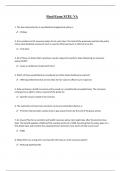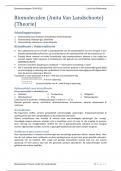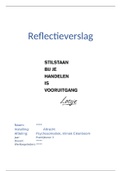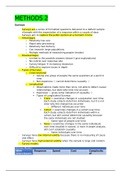Delicts – Semester 2
Module Framework change: page 14: Theme 15 eliminated
Test will cover 2nd semester work only, 30 marks, same format as June test
Revision of 1st Semester:
5 requirements of delictual liability = harm (cornerstone) either patrimonial or non-patrimonial; conduct (either positive or negative);
causation (factual and legal); fault (additional enquiry of accountability before looking at blameworthiness in the form of either intention or
negligence); wrongfulness and grounds of justification (defenses excluding wrongfulness).
Legal principles & rules were discussed, e.g. traditional way to assess patrimonial harm comparative method (position before delict and
position hypothetical position if there was no delict – often falls flat, e.g. wrongful life); conduct (fundamental requirements, voluntariness,
connection must be drawn between D’s conduct & P’s harm = causation); factual causation (common law but for test – not always useful,
problem cases e.g. in Lee CC judgement – nevertheless it remain the test on a balance of probabilities) and legal causation via flexible
approach in Mokgethi (sufficiently close connection? taking policy considerations into account based on justice, fairness & reasonableness
– subsidiary tests); fault (accountability: right & wrong and ability to act in accordance to such distinction) blameworthiness: intention =
wanting to cause harm, knowing that it was wrong//negligence = accidental, but could still be liable – reasonable person standard
comparison (test for negligence subjectified); wrongfulness (basic legal rules always to remember, causation of bodily injuries & property
damage through positive conduct is prima facie wrongful, causation of harm through negative conduct is not prima facie wrongful, and also
not pure economic loss cases – this element thus becomes an issue in such cases.
2nd semester: we look at practical issues applied, especially where wrongfulness comes into question. Omissions, pure economic loss,
personality rights & dignity, defamation, vicarious liability etc.
Remember: we follow the case system. Case Law is more important now than ever.
Theme 12: Liability for an Omission
30/07
(Chapter 14) = NB cases
Minister van Polisie v Ewels 1975 (3) SA 590 (A)
Cape Town Municipality v Bakkerud 2000 (3) SA 1049 (SCA)
Minister of Safety and Security v Van Duivenboden 2002 (6) SA 431 (SCA)
Van Eeden v Minister of Safety and Security [2002] 4 All SA 346 (SCA)
Minister of Safety and Security v Carmichele 2004 (3) SA 305 (SCA)
Overview
1. Context: see lecture notes above.
2. Historical development of the law as it relates to the liability for omissions.
3. Contemporary SA law – application of legal rules & principles (as it exists in contemporary SA context)
+ then we turn to the practical side thereof.
1. Thought process
1
, 2. Wrongfulness: policy considerations – NB for test & exam.
4. Practical problem question – how to answer! Get distinction for 2nd test, bitch.
- Recall from 1st semester regarding historical dev of the requirements for wrongfulness.
- First traditional approach in omission case asked: was there a legal duty on the defendant to take
positive action and to prevent the harm in question? Whether a legal duty existed would be determined
by having regard to the boni mores (legal convictions of the community).
- Gradually, a development occurred. Current question is no longer whether there was a legal duty to
act positively to prevent harm, bc the legal duty leads to confusion (English law duty of care) with
negligence (conflation of WF and N).
- Today, we ask (in an omission case): is it reasonable for the court to impose delictual liability on the
defendant for the defendant’s failure to act?
- Legal public policy considerations, constitutional rights & public policy norms (NOT boni mores, bc the
community has no ascertainable convictions on omission liability). – recall from 1st semester.
Historical development
Roman law – Roman jurists had to deal with the issue of whether Aquilian liability would also apply if someone
simply failed to act. What did Roman jurists say where there was an omission? Broadly,
1. Focus: practical solution, not to develop general legal principles to create precedent – case-by-case (ad
hoc) approach. One case could be dealt with in a specific manner, where another case would be dealt
with very differently. They thus followed a-
2. Casuistic system – problem not solved by general principle, but each case dealt with separately and in
a different fashion.
Roman-Dutch law (16th – 18th Century)
1. General position: one cannot be held liable in delict for a failure to act. Immune from liability if you
failed to act. Positive conduct was not problematic, but from a legal, philosophical standpoint,
omissions were not initially wrongful. Some jurists advocated for imposing liability on a defendant’s
failure to act -
2. Voet: agreed with retaining general position, but argued for exceptions:
1. Prior conduct e.g. starting the fire and failing to put it out = liable, bc there was positive conduct preceding
the failure to act. Caused the source of danger, risk & harm through his prior positive conduct.
2. Express acceptance of duty by Defendant & failure to comply. E.g. if you agreed it was your duty that the
fire would be put out at a certain time, but you failed to and this caused the house to burn down = liable for
failure to act positively in accordance to the duty that you accepted.
3. Matthaeus: culpa is all-embracing measure. He was more radical than Voet.
- We should have one principle to decide whether any omission case should attract liability in Delict à
Culpa (Fault)
- Specifically, fault in the form of negligence occurs where a person negligently failed to act which caused
harm, liability should thus follow.
- Difference from M’s position and modern SA = His formulation does not include the requirement for
WF.
Must still be researched:
1. Customary law? – pre & postcolonial African customs not codified?
2
, 2. African jurisdictions? – interesting research project.
Modern SA law: English Law influences in so-called “Municipality cases”
- Position in 1912 generally – there was immunity for liability for an omission (same as the general
position maintained under RDL – failure to act does not give rise to a delictual L)
- Position reconsidered:
1. Halliwell v Johannesburg Municipal Council 1912 AD 659:
P was injured when his horsed slipped on cobbles properly laid, but dangerously slippery bc they were
smooth as they worn out over the years. AD upheld the claim for damages (ground-breaking), but why?
Fundamental reason in extract below = prior conduct by the D that actually created the dangerous
risk situation and failure to act. Reflects position of RDL (generally immunity, but exception of prior
conduct).
Immunity and the doctrine of prior conduct
“[T]he general principle adopted [is] that a road authority which is empowered but not obliged to repair the
public thoroughfares is not liable for damages resulting from mere failure to do so (RDL). But in none of the cases
has the element been present which is such an important feature of this inquiry, namely, the circumstance that
the injury complained of has been really caused by previous acts of construction or repair. And applying the
general principles of our law to that circumstance, I think that where a road authority either constructs or
repairs a street in such a way as to introduce a new source of danger which would otherwise not have existed,
then it must take due steps to guard against that danger […] Any omission to discharge this duty would entail
liability in damages to any injured person to whom it was owed. The omission would be connected with the
positive act which originated the danger, and the fault would be not one of omission alone, but of omission and
commission combined.” = RDL decision
– the above decision was maintained for some years, for example:
2. Cape Town Municipality v Paine 1923 AD 207 – re-affirmed that the rule is:
“[M]ere omission did not under the lex Aquilia constitute [liability]; it only did so when connected with prior
conduct.” General rule was that liability will not be imposed for failure to act (any defendant), however, when
we deal with a municipality that created a dangerous situation through it’s prior conduct & fails to act positively
to prevent danger arising from such conduct – only then can delictual liability be imposed…
Doctrine of prior conduct lead to an artificial search for some prior positive act on which to establish liability,
where the real reason for the decision clearly lay elsewhere – tendency as seen in:
3. South African Railways and Harbours v Estate Saunders 1931 AD 276:
D (Railways) had left a trailer at the store of a company to be unloaded and fetched later. This was in
accordance with the usual practice followed by the two parties. Servants of company unloaded trailer
and pushed it in adjacent road and informed D by telephone that it was ready for collection. D failed to
collect, and it remained in the road in the dark, without lights. Bus owned by P then collided with the
trailer. Court held D liable for damages in Delict, for negligently failing to remove the trailer. JA Stratford
said liability was based on the doctrine of prior conduct. According to the court – the prior conduct of
the D was that it had allowed the trailer to pass out of its custody in terms as above.
1. Application of prior conduct doctrine – D allowed trailer to pass out of its custody in the terms
& understanding as above… but the problem with the PCD is that:
3
, 2. Unclear exactly what kind of conduct amounts to prior conduct for the purpose of allowing
liability to be imposed in delict?
AD created this doctrine without setting out criteria for this exceptional category. What must
nature of the conduct be? (no clear indication) Courts had to determine this prior conduct on
its own, and then courts started to look for prior conduct of any nature to fit the doctrine.
However, prior conduct does not have equivalent results (Halliwell decision – if you think of
the prior conduct, it was clear the conduct created a dangerous situation, but not the same as
the conduct in this case). Problem with the PCD = There is always prior conduct à Thus always
possible for the courts to find prior conduct + say that L must be based on that prior conduct.
3. Arbitrary results à similar situations had different outcomes under this doctrine. Sometimes
L would follow, other times it would not.
Application of doctrine and irreconcilable decisions -
Van den Heever, Aquilian Damages in South African Law (1945)
“The doctrine of previous conduct is not harmless; it has caused confusion and led our courts to give irreconcilable
decisions unless we find the reconciliation in pure casuistry.” No reconciliation, doctrine applied arbitrarily.
Should be developed. 2 proposals:
1. Van den Heever’s proposal: culpa as ultimate measure to determine liability for a failure to act – instead
of general rule & doctrine. (as M in RDL said)
We must say that a person can, in general, be held liable for its failure to act, IF he was negligent à We
must thus use culpa to determine if someone should be held L.
Appellate division rejects proposal
2. Beinart and McKerron’s proposal: iniuria (wrongfulness) as ultimate measure in SA law of delict, (before
it was firmly developed in 1950’s).
- Instead of using culpa, we must use iniuria – get our grip on the concept of WF in the law of Delict in
SA. Once we have developed this concept (as an independent requirement for WF), Wf should be used
as a measure to help us determine whether or not L should be imposed for someone’s failure to prevent
harm.
Modern SA law – the following 3 decisions show the gradual willingness of the AD to use wrongfulness to
determine liability for failure to prevent harm…
1. Silva’s Fishing Corporation (Pty) Ltd v Maweza 1957 (A)
Respondent’s husband (who was the member of a fishing boat owned by the D) died, they instituted
claim of damages against appellant (owner of fishing boat) who knew of crew’s plight but failed to act.
Court unanimously held that there was a (legal) duty to (take positive steps to) rescue, majority said
that the duty to rescue was not subject to special rules – held that L in delict should be imposed.
Real significance of this case lies in:
Minority judgement of JA Steyn NB: à legal duty concept, break away from shackles of the “prior
conduct” doctrine and look at circumstances. We must pay attention to the bonis mores.
“[A]n omission does not entail delictual liability where there is no legal duty to act, that generally speaking
such a duty will arise from a prior act or from prior conduct, but that it could also arise from some other source,
4
Module Framework change: page 14: Theme 15 eliminated
Test will cover 2nd semester work only, 30 marks, same format as June test
Revision of 1st Semester:
5 requirements of delictual liability = harm (cornerstone) either patrimonial or non-patrimonial; conduct (either positive or negative);
causation (factual and legal); fault (additional enquiry of accountability before looking at blameworthiness in the form of either intention or
negligence); wrongfulness and grounds of justification (defenses excluding wrongfulness).
Legal principles & rules were discussed, e.g. traditional way to assess patrimonial harm comparative method (position before delict and
position hypothetical position if there was no delict – often falls flat, e.g. wrongful life); conduct (fundamental requirements, voluntariness,
connection must be drawn between D’s conduct & P’s harm = causation); factual causation (common law but for test – not always useful,
problem cases e.g. in Lee CC judgement – nevertheless it remain the test on a balance of probabilities) and legal causation via flexible
approach in Mokgethi (sufficiently close connection? taking policy considerations into account based on justice, fairness & reasonableness
– subsidiary tests); fault (accountability: right & wrong and ability to act in accordance to such distinction) blameworthiness: intention =
wanting to cause harm, knowing that it was wrong//negligence = accidental, but could still be liable – reasonable person standard
comparison (test for negligence subjectified); wrongfulness (basic legal rules always to remember, causation of bodily injuries & property
damage through positive conduct is prima facie wrongful, causation of harm through negative conduct is not prima facie wrongful, and also
not pure economic loss cases – this element thus becomes an issue in such cases.
2nd semester: we look at practical issues applied, especially where wrongfulness comes into question. Omissions, pure economic loss,
personality rights & dignity, defamation, vicarious liability etc.
Remember: we follow the case system. Case Law is more important now than ever.
Theme 12: Liability for an Omission
30/07
(Chapter 14) = NB cases
Minister van Polisie v Ewels 1975 (3) SA 590 (A)
Cape Town Municipality v Bakkerud 2000 (3) SA 1049 (SCA)
Minister of Safety and Security v Van Duivenboden 2002 (6) SA 431 (SCA)
Van Eeden v Minister of Safety and Security [2002] 4 All SA 346 (SCA)
Minister of Safety and Security v Carmichele 2004 (3) SA 305 (SCA)
Overview
1. Context: see lecture notes above.
2. Historical development of the law as it relates to the liability for omissions.
3. Contemporary SA law – application of legal rules & principles (as it exists in contemporary SA context)
+ then we turn to the practical side thereof.
1. Thought process
1
, 2. Wrongfulness: policy considerations – NB for test & exam.
4. Practical problem question – how to answer! Get distinction for 2nd test, bitch.
- Recall from 1st semester regarding historical dev of the requirements for wrongfulness.
- First traditional approach in omission case asked: was there a legal duty on the defendant to take
positive action and to prevent the harm in question? Whether a legal duty existed would be determined
by having regard to the boni mores (legal convictions of the community).
- Gradually, a development occurred. Current question is no longer whether there was a legal duty to
act positively to prevent harm, bc the legal duty leads to confusion (English law duty of care) with
negligence (conflation of WF and N).
- Today, we ask (in an omission case): is it reasonable for the court to impose delictual liability on the
defendant for the defendant’s failure to act?
- Legal public policy considerations, constitutional rights & public policy norms (NOT boni mores, bc the
community has no ascertainable convictions on omission liability). – recall from 1st semester.
Historical development
Roman law – Roman jurists had to deal with the issue of whether Aquilian liability would also apply if someone
simply failed to act. What did Roman jurists say where there was an omission? Broadly,
1. Focus: practical solution, not to develop general legal principles to create precedent – case-by-case (ad
hoc) approach. One case could be dealt with in a specific manner, where another case would be dealt
with very differently. They thus followed a-
2. Casuistic system – problem not solved by general principle, but each case dealt with separately and in
a different fashion.
Roman-Dutch law (16th – 18th Century)
1. General position: one cannot be held liable in delict for a failure to act. Immune from liability if you
failed to act. Positive conduct was not problematic, but from a legal, philosophical standpoint,
omissions were not initially wrongful. Some jurists advocated for imposing liability on a defendant’s
failure to act -
2. Voet: agreed with retaining general position, but argued for exceptions:
1. Prior conduct e.g. starting the fire and failing to put it out = liable, bc there was positive conduct preceding
the failure to act. Caused the source of danger, risk & harm through his prior positive conduct.
2. Express acceptance of duty by Defendant & failure to comply. E.g. if you agreed it was your duty that the
fire would be put out at a certain time, but you failed to and this caused the house to burn down = liable for
failure to act positively in accordance to the duty that you accepted.
3. Matthaeus: culpa is all-embracing measure. He was more radical than Voet.
- We should have one principle to decide whether any omission case should attract liability in Delict à
Culpa (Fault)
- Specifically, fault in the form of negligence occurs where a person negligently failed to act which caused
harm, liability should thus follow.
- Difference from M’s position and modern SA = His formulation does not include the requirement for
WF.
Must still be researched:
1. Customary law? – pre & postcolonial African customs not codified?
2
, 2. African jurisdictions? – interesting research project.
Modern SA law: English Law influences in so-called “Municipality cases”
- Position in 1912 generally – there was immunity for liability for an omission (same as the general
position maintained under RDL – failure to act does not give rise to a delictual L)
- Position reconsidered:
1. Halliwell v Johannesburg Municipal Council 1912 AD 659:
P was injured when his horsed slipped on cobbles properly laid, but dangerously slippery bc they were
smooth as they worn out over the years. AD upheld the claim for damages (ground-breaking), but why?
Fundamental reason in extract below = prior conduct by the D that actually created the dangerous
risk situation and failure to act. Reflects position of RDL (generally immunity, but exception of prior
conduct).
Immunity and the doctrine of prior conduct
“[T]he general principle adopted [is] that a road authority which is empowered but not obliged to repair the
public thoroughfares is not liable for damages resulting from mere failure to do so (RDL). But in none of the cases
has the element been present which is such an important feature of this inquiry, namely, the circumstance that
the injury complained of has been really caused by previous acts of construction or repair. And applying the
general principles of our law to that circumstance, I think that where a road authority either constructs or
repairs a street in such a way as to introduce a new source of danger which would otherwise not have existed,
then it must take due steps to guard against that danger […] Any omission to discharge this duty would entail
liability in damages to any injured person to whom it was owed. The omission would be connected with the
positive act which originated the danger, and the fault would be not one of omission alone, but of omission and
commission combined.” = RDL decision
– the above decision was maintained for some years, for example:
2. Cape Town Municipality v Paine 1923 AD 207 – re-affirmed that the rule is:
“[M]ere omission did not under the lex Aquilia constitute [liability]; it only did so when connected with prior
conduct.” General rule was that liability will not be imposed for failure to act (any defendant), however, when
we deal with a municipality that created a dangerous situation through it’s prior conduct & fails to act positively
to prevent danger arising from such conduct – only then can delictual liability be imposed…
Doctrine of prior conduct lead to an artificial search for some prior positive act on which to establish liability,
where the real reason for the decision clearly lay elsewhere – tendency as seen in:
3. South African Railways and Harbours v Estate Saunders 1931 AD 276:
D (Railways) had left a trailer at the store of a company to be unloaded and fetched later. This was in
accordance with the usual practice followed by the two parties. Servants of company unloaded trailer
and pushed it in adjacent road and informed D by telephone that it was ready for collection. D failed to
collect, and it remained in the road in the dark, without lights. Bus owned by P then collided with the
trailer. Court held D liable for damages in Delict, for negligently failing to remove the trailer. JA Stratford
said liability was based on the doctrine of prior conduct. According to the court – the prior conduct of
the D was that it had allowed the trailer to pass out of its custody in terms as above.
1. Application of prior conduct doctrine – D allowed trailer to pass out of its custody in the terms
& understanding as above… but the problem with the PCD is that:
3
, 2. Unclear exactly what kind of conduct amounts to prior conduct for the purpose of allowing
liability to be imposed in delict?
AD created this doctrine without setting out criteria for this exceptional category. What must
nature of the conduct be? (no clear indication) Courts had to determine this prior conduct on
its own, and then courts started to look for prior conduct of any nature to fit the doctrine.
However, prior conduct does not have equivalent results (Halliwell decision – if you think of
the prior conduct, it was clear the conduct created a dangerous situation, but not the same as
the conduct in this case). Problem with the PCD = There is always prior conduct à Thus always
possible for the courts to find prior conduct + say that L must be based on that prior conduct.
3. Arbitrary results à similar situations had different outcomes under this doctrine. Sometimes
L would follow, other times it would not.
Application of doctrine and irreconcilable decisions -
Van den Heever, Aquilian Damages in South African Law (1945)
“The doctrine of previous conduct is not harmless; it has caused confusion and led our courts to give irreconcilable
decisions unless we find the reconciliation in pure casuistry.” No reconciliation, doctrine applied arbitrarily.
Should be developed. 2 proposals:
1. Van den Heever’s proposal: culpa as ultimate measure to determine liability for a failure to act – instead
of general rule & doctrine. (as M in RDL said)
We must say that a person can, in general, be held liable for its failure to act, IF he was negligent à We
must thus use culpa to determine if someone should be held L.
Appellate division rejects proposal
2. Beinart and McKerron’s proposal: iniuria (wrongfulness) as ultimate measure in SA law of delict, (before
it was firmly developed in 1950’s).
- Instead of using culpa, we must use iniuria – get our grip on the concept of WF in the law of Delict in
SA. Once we have developed this concept (as an independent requirement for WF), Wf should be used
as a measure to help us determine whether or not L should be imposed for someone’s failure to prevent
harm.
Modern SA law – the following 3 decisions show the gradual willingness of the AD to use wrongfulness to
determine liability for failure to prevent harm…
1. Silva’s Fishing Corporation (Pty) Ltd v Maweza 1957 (A)
Respondent’s husband (who was the member of a fishing boat owned by the D) died, they instituted
claim of damages against appellant (owner of fishing boat) who knew of crew’s plight but failed to act.
Court unanimously held that there was a (legal) duty to (take positive steps to) rescue, majority said
that the duty to rescue was not subject to special rules – held that L in delict should be imposed.
Real significance of this case lies in:
Minority judgement of JA Steyn NB: à legal duty concept, break away from shackles of the “prior
conduct” doctrine and look at circumstances. We must pay attention to the bonis mores.
“[A]n omission does not entail delictual liability where there is no legal duty to act, that generally speaking
such a duty will arise from a prior act or from prior conduct, but that it could also arise from some other source,
4










